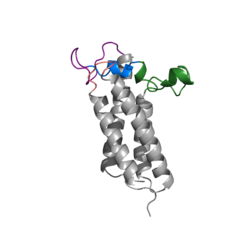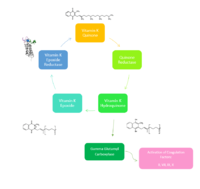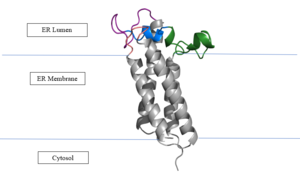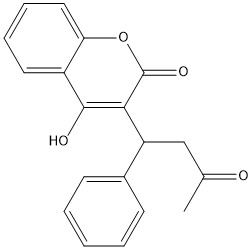Sandbox Reserved 1717
From Proteopedia
(Difference between revisions)
| Line 10: | Line 10: | ||
== Introduction == | == Introduction == | ||
| - | [[Image:NewVitaminKCycle.PNG|200px|right|thumb|Figure 2. Overview of Vitamin K Cycle]] | + | [[Image:NewVitaminKCycle.PNG|200px|right|thumb|'''Figure 2. Overview of Vitamin K Cycle''': The cycle begins with Vitamin K Quinone. Vitamin K Quinone is reduced by enzyme Quinone Reductase. This leaves Vitamin K Hydroquinone which can either lead to Gamma Carboxylase activity that will activate Blood Coagulation Factors II, VII, IX, and X. After this, Vitamin K Epoxide is left over. Vitamin K Epoxide is reduced by the enzyme Vitamin K Epoxide Reductase to reform Vitamin K Quinone. ]] |
| - | '''Vitamin K Epoxide Reductase''' (VKOR) is an endoplasmic membrane enzyme that generates the active form of Vitamin K to support blood coagulation. VKOR homologs are | + | '''Vitamin K Epoxide Reductase''' <scene name='90/904321/Closedconformation/2'>Spinning VKOR</scene> |
| + | [https://en.wikipedia.org/wiki/Vitamin_K_epoxide_reductase VKOR WIKI](VKOR) is an endoplasmic membrane enzyme that generates the active form of Vitamin K to support blood coagulation. VKOR homologs are integral membrane thiol oxidoreductases due to the function of VKOR being dependent on thiol residues and disulfide bonding. The Vitamin K Cycle and the VKOR enzyme specifically are common drug targets for thromboembolic diseases. This is because, as pictured, the vitamin K cycle is required to activate blood coagulant factors II, VII, IX, and X. Coagulant factor activation promotes blood clotting, which in high amounts can be dangerous and cause thromboembolic diseases such as stroke, deep vein thrombosis, and/or pulmonary embolism. Vitamin K Epoxide Reductase is found and primarily synthesized in the liver. It is embedded in the membrane known as the endoplasmic reticulum. | ||
| + | == Structure == | ||
| + | The VKOR enzyme is made up of four transmembrane helices: T1, T2, T3, and T4.(Grey) Each of these helices come together to form a central ligand binding pocket. This central pocket is the active site where conserved Cysteines: C132 and C135 are located. In the cap domain are important regions that are significant for Vitamin K binding, and the overall function of Vitamin K Epoxide Reductase, including the Anchor(Green), Cap Sequence (Blue), Beta Hairpin (Purple), and 3-4 Loop (Pink). | ||
| - | + | '''The Anchor''' attaches to the cap domain of the Vitamin K Epoxide Reductase Enzyme and is partially embedded in the Endoplasmic Reticulum Membrane. This both stabilizes the enzyme in the membrane, and stabilizes the cap domain over the active site. | |
| - | + | ||
| - | Vitamin K Epoxide | + | '''The Cap Sequence''' is two parts: The cap helix and the cap loop. When the enzyme is reducing Vitamin K Epoxide or being inhibited by Vitamin K Antagonists, this cap region swings downward over the active site. The cap region is directly attached to the anchor. |
| + | ''' | ||
| + | '''The Beta Hairpin''' is only seen in the closed conformation of Vitamin K Epoxide Reductase. When in the open conformation the beta hairpin is referred to as the luminal helix (yellow). The Beta hairpin is significant due to the fact that it contains the other two conserved cysteines necessary for the function of Vitamin K Epoxide Reductase: Cysteine43 and Cysteine51. The beta hairpin/luminal helix is directly connected to the cap region. | ||
| + | '''The 3-4 Loop''' is the sequence of residues between Transmembrane Helix 3 and Transmembrane Helix 4. In the open conformation the loop does not have significant interactions with the rest of the cap domain, however in the closed conformation Loop 3-4 has many hydrogen reactions with the Cap Loop. This allows for the stabilization when VKOR is closed. | ||
| + | The transmembrane helices are located in the Endoplasmic Reticulum Luminal Region, which is the region between the ER Lumen and the Cytosol. Vitamin K Epoxide Reductase is unstable in-vitro. To determine its structure an extra protein, sfGFP: superfolder green flourescent protein, was appended to the N and C termini of Vitamin K Epoxide. For the visualizing VKOR, this protein has been removed from the structural scenes. | ||
| + | [[Image:VKORmembrane.png|300px|left|thumb|Figure 3. Orientation in Endoplasmic Reticulum: The cap region is partially oriented in the ER Lumen, however the active site remains within the ER membrane. The Beta Hairpin, Loop 3-4, Cap Loop are all in the ER Lumen. The Anchor is partially within the ER lumen, and partially embedded in the ER membrane. The anchor is what attaches the cap domain and stabilizes it, which allows the cap domain to cover the active site. ]] | ||
| + | The reaction catalyzed by VKOR is a redox reaction. ''Vitamin K Epoxide => Vitamin K Quinone'' Vitamin K Epoxide is reduced by transferring two electrons through a disulfide bond. These disulfide bonds come from the conserved cysteines. This redox reaction that is catalyzed by VKOR produces Vitamin K Quinone. | ||
| Line 32: | Line 40: | ||
| - | |||
| - | == Structure == | ||
| - | <scene name='90/904321/Closedconformation/2'>Spinning VKOR</scene> | ||
| - | [https://en.wikipedia.org/wiki/Vitamin_K_epoxide_reductase VKOR WIKI] | ||
| - | The VKOR enzyme is made up of four transmembrane helices: T1, T2, T3, and T4.(Grey) Each of these helices come together to form a central pocket, that is topped by a cap domain. In the cap domain are important regions that are significant for Vitamin K binding, and the overall function of Vitamin K Epoxide Reductase. These important regions are the Anchor(Green), Cap Region (Blue), Beta Hairpin (Purple), and 3-4 Loop (Pink). The transmembrane helices form the central pocket that is also the active site of the enzyme. This is because the catalytic cysteines Cys132 and Cys135 are located in this region of the enzyme. | ||
| - | |||
| - | The transmembrane helices make up the ER-luminal region, which is large and flexible. Vitamin K Epoxide Reductase is known for its in-vitro instability. When trying to view the structure an extra protein known as sfGFP, superfolder green flourescent protein, is bound the N and C termini of Vitamin K Epoxide. For the purpose of viewing the structure, this protein has been removed from the pdb files. | ||
| - | |||
| - | <ref name="Ransey">PMID:28504306</ref> | ||
===Transmembrane Helices=== | ===Transmembrane Helices=== | ||
| - | The Transmembrane helices | + | The Transmembrane region has four helices, labeled 1-4. Transmembrane Helix 2 (TM2) and 4 (TM4) contribute to the binding of Vitamin K to the hydrophobic pocket for reduction. Asparagine 83 on TM2 and Tyrosine 142 on TM4 hydrogen bond to Vitamin K Epoxide to hold it in the correct orientation for reduction. The angle in which Vitamin K Epoxide binds in the central pocket is significant to the placement of the beta hairpin, and loop 3-4, Cysteine residues C51-C132 will donate their electrons to Vitamin K Epoxide (Fig. 4) to open the epoxide ring, and reform Vitamin K Quinone (Fig. 2). |
===Cap Domain=== | ===Cap Domain=== | ||
| Line 48: | Line 47: | ||
The cap domain of Vitamin K Epoxide Reductase plays an intricate role in its function. When Vitamin K Epoxide (or a similar substrate) binds in the hydrophobic pocket of VKOR, the cap domain undergoes a conformational change that will allow for specific cysteine residues to be able to open the epoxide ring and to recreate Vitamin K Quinone. The catalytic cycle begins in an open fully oxidized conformation. <scene name='90/904321/Openvkor/3'>Open Oxidized Conformation</scene> This conformation has slightly different parts. These include the Anchor (green), the cap region (blue), 3-4 Loop (pink), and luminal helix (yellow). When Vitamin K Epoxide binds, the entire cap domain undergoes a slight conformation change, but the luminal helix has a larger change. The luminal helix (yellow) bends forward where specific cysteines on this region are in proximity to other important cysteines. The luminal helix is then referred to as the beta hairpin (purple). <scene name='90/904321/Vkoclosed/3'>Partially Oxidized Closed Conformation</scene> | The cap domain of Vitamin K Epoxide Reductase plays an intricate role in its function. When Vitamin K Epoxide (or a similar substrate) binds in the hydrophobic pocket of VKOR, the cap domain undergoes a conformational change that will allow for specific cysteine residues to be able to open the epoxide ring and to recreate Vitamin K Quinone. The catalytic cycle begins in an open fully oxidized conformation. <scene name='90/904321/Openvkor/3'>Open Oxidized Conformation</scene> This conformation has slightly different parts. These include the Anchor (green), the cap region (blue), 3-4 Loop (pink), and luminal helix (yellow). When Vitamin K Epoxide binds, the entire cap domain undergoes a slight conformation change, but the luminal helix has a larger change. The luminal helix (yellow) bends forward where specific cysteines on this region are in proximity to other important cysteines. The luminal helix is then referred to as the beta hairpin (purple). <scene name='90/904321/Vkoclosed/3'>Partially Oxidized Closed Conformation</scene> | ||
| - | == | + | == Vitamin K Epoxide == |
| - | + | [[Image:Vitamin K epoxide.jpg|500 px|right|thumb|Figure 1. Vitamin K Epoxide structure]] | |
| + | As mentioned above, Vitamin K epoxide is a part of the Vitamin K cycle and required for blood coagulation. In the cycle, VKOR reduces Vitamin K epoxide to naphthoquinone, or the active form of Vitamin K. In this conversion, VKOR donates electrons to Vitamin K epoxide from the S-H of the active cysteine pair, Cys132-Cys135, discussed above. The active cysteine pair is oxidized in this process. It is returned to its active form with the reduction of the mediated cysteine pairs, Cys43-Cys51. | ||
| - | == | + | === Binding === |
| + | To start, VKOR is in its open conformation. The Vitamin K epoxide enters. The oxygens of the ketones bind to Asn80 and Tyr139. With Vitamin K epoxide in its place, the conformation of VKOR is partially oxidized in regards to the cysteine pairs, which overall leads to the reduction of the substrate. A disulfide bond forms between Cys51 and Cys132, resulting in the closed conformation. This leaves the sulfur on Cys43 and the sulfur on Cys135 protonated. The available hydrogens on these cysteines are utilized in reducing the epoxide. First, the sulfur on Cys51 and Cys43 form a new bond. The hydrogen from Cys43 binds to the oxygen in the epoxide. The sulfur on Cys132 and the sulfur on Cys15 then form a new disulfide bond. The hydrogen that was present on Cys135 forms a new bond with the oxygen of the epoxide. With these cysteine pairs formed, VKOR is left in an open conformation. The end products are Vitamin K/quinone and water. | ||
| - | [[Image:Vitamin K epoxide.jpg|500 px|right|thumb|Figure 4. Vitamin K Epoxide structure]] | ||
| - | As mentioned above, Vitamin K epoxide is a part of the Vitamin K cycle and required for blood coagulation. In the cycle, VKOR reduces Vitamin K epoxide to naphthoquinone, or the active form of Vitamin K. In this conversion, VKOR donates electrons to Vitamin K epoxide from the S-H of the active cysteine pair, Cys132-Cys135, discussed above. The active cysteine pair is oxidized in this process. It is returned to its active form with the reduction of the mediated cysteine pairs, Cys43-Cys51. | ||
| + | ==Catalytic Cysteines== | ||
| + | |||
| + | A set of four cysteines is consistently conserved in all VKOR homologs. In the human homolog (HsVKOR) these cysteines are Cys43, Cys51, Cys132, and Cys 135. <scene name='90/904321/Cysteines/6'>Significant Cysteines</scene> In the Pufferfish homolog (TrVKORL) these cysteines, due to Cryo-EM differences,are Cys52, Cys55, Cys141, and Cys144. These cysteines are the key factor that allow for Vitamin K Epoxide Reductase to perform its function, which is to open the epoxide ring on Vitamin K Epoxide in order to re-make Vitamin K Quinone. In the closed conformation, that is induced when Vitamin K binds in the hydrophobic pocket, Cys-132 binds to Cys-51 and Cys-135 will bind to the 3' hydroxyl group on Vitamin K Epoxide, which allows for the electron transfer to open up the epoxide ring. <scene name='90/904321/Cys52disulfidecys55/9'>Electron Transfer through Cysteine138 TrVKORL</scene> | ||
| - | === Binding === | ||
| - | To start, VKOR is in its <scene name='90/904322/Open_conformation/1'>open conformation</scene>. The Vitamin K epoxide enters through the isoprenyl- chain tunnel. The oxygens of the ketones bind to <scene name='90/904322/Vko_binding/1'>Asn80 and Tyr139</scene>. With Vitamin K epoxide in its place, the conformation of VKOR is partially oxidized in regards to the cysteine pairs, which overall leads to the reduction of the substrate. A disulfide bond forms between Cys51 and Cys132, resulting in the closed conformation. This leaves the sulfur on Cys43 and the sulfur on Cys135 protonated. The available hydrogens on these cysteines are utilized in reducing the epoxide. First, the sulfur on Cys51 and Cys43 form a new bond. The hydrogen from Cys43 binds to the oxygen in the epoxide. The sulfur on Cys132 and the sulfur on Cys135 then form a new disulfide bond. The hydrogen that was present on Cys135 forms a new bond with the oxygen of the epoxide. With these cysteine pairs formed, VKOR is left in an open conformation. The end products are the Vitamin K/quinone and water. | ||
Revision as of 18:49, 5 April 2022
Vitamin K Epoxide Reductase
| |||||||||||





